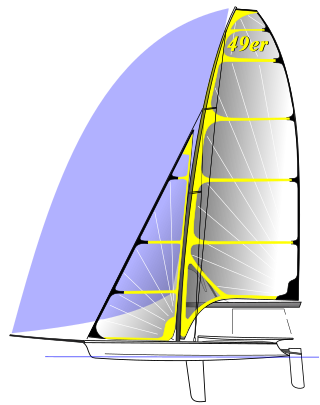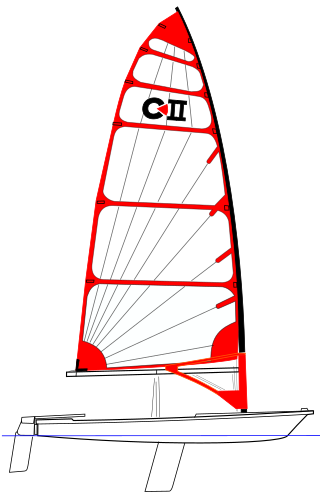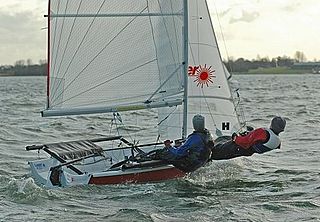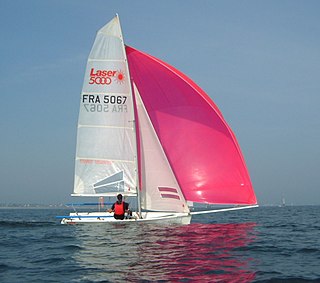Related Research Articles

The Laser is a class of single-handed, one-design sailing dinghies using a common hull design with three interchangeable rigs of different sail areas, appropriate to a given combination of wind strength and crew weight. Bruce Kirby designed the Laser in 1970 with an emphasis on simplicity and performance.
The Portsmouth Yardstick (PY) or Portsmouth handicap scheme is a term used for a number of related systems of empirical handicapping used primarily in small sailboat racing.

The 49er and 49er FX is a two-handed skiff-type high-performance sailing dinghy. The two crew work on different roles with the helm making many tactical decisions, as well as steering, and the crew doing most of the sail control. Both of the crew are equipped with their own trapeze and sailing is done while cantilevered over the water to the fullest extent to balance against the sails.

The Byte is a small one-design sailing dinghy sailed by one person. It was designed by Canadian Ian Bruce, who also commissioned and marketed the Laser.

The Laser 2, or Laser II, is a sailboat that was designed by New Zealander Frank Bethwaite and Canadian Ian Bruce as a one-design racer and first built in 1978.

The Laser Pico dinghy is a small sailboat designed by Jo Richards in the mid-1990s and used primarily for training and day sailing. It can be crewed by one or two children or an adult. Current models come equipped with both a mainsail and a jib, the jib however mainly functions as a training tool and provides little to no contribution to speed. The Pico functions mainly as a training boat for younger children because of its very durable nature and has little to no racing events dedicated to it.

The Fireball is a British sailing dinghy that was designed by Peter Milne as a one-design racer and first built in 1962.

The Laser 4000(now "4000") is a racing dinghy designed by Phil Morrison crewed by two persons. Its one-design weight-equalised system enables physically differing sailors to compete on a level playing field. It is most popular in Europe, particularly the UK, France and Italy.

The International 14 is a British racing sailboat, crewed by two sailors. The class was established in 1928.

The Laser Stratos is an all-round cruising and racing boat designed by Phil Morrison and built by LaserPerformance, the same company as the famous Laser Standard dinghy. It is built from fibre-glass and foam sandwich. The Laser Stratos comes in two forms, one with a keel and one with a centreboard. The centreboard version is red and the keel version is blue. The Stratos is quite spacious and most of the rigging is kept out of the way. The boat can optionally be fitted with trapeze lines and an engine bracket for carrying an outboard engine.

The RS300 is a modern racing sailing dinghy made by RS Sailing. The RS300 is a one-design, single-handed, hiking dinghy with a PY of 972. Designed by Clive Everest and first produced in 1998, it is inspired by the International Moth, of which Everest was a successful designer.

The RS800 is a light-weight sailing dinghy designed by Phil Morrison and manufactured by RS Sailing. The boat is sailed by two people both on trapeze and has a main, jib and spinnaker. The RS800 has a Portsmouth Yardstick number of 799 and a D-PN of 77.0. There is a large racing circuit in the UK, and some European events each year.
The Scorpion is a British National class of a small sailing dinghy. The Scorpion is a lightweight, high performance, two person, hiking racing dinghy. Its adjustable rig enables sailing in all weathers for crews of all weights, ages and experiences. The Scorpion was originally designed for launch and recovery through Cornish surf at Porthpean in St Austell Bay. Its 14ft hard chine planing hull is built to strict measurements while rig controls and cockpit layout are left to personal choice.

The International Canoe (IC) is a powerful and extremely fast single-handed sailing canoe whose rules are governed by the International Canoe Federation.

The 3000 is a racing sailing dinghy crewed by two persons with a trapeze for the crew. Launched in 1996 as the Laser 3000, the 3000 was developed from the Laser 2, using the original Frank Bethwaite-designed planing hull combined with a new designed self-draining deck by Derek Clark. Clark also re-designed the rig, using spars and sails from premium proprietary sources and replacing the symmetric spinnaker of the Laser 2 by a larger asymmetric spinnaker (gennaker). The gennaker is chute-launched and retrieved using a single halyard line, and is set on a retractable bowsprit. Helm balance and handling were improved using a shorter-footed mainsail with two full-width battens giving a larger roach. A mast with conventional spreaders replaced the now-unusual diamond arrangement of the Laser 2.
The 2000(formerly the Laser 2000) is a performance sailing dinghy designed by Phil Morrison and currently sold by RS Sailing. It combines a traditional GRP hull and foam sandwich deck moulding with a modern asymmetric rig including a furling jib, reefing mainsail and single line gennaker hoist system.

The Laser Vago is a British/American sailing dinghy that was designed by Jo Richards as a one-design racer and first built in 2005.
The Splash Dinghy is 3.5 m in length and all boats are identical, thus, as is typical in One-Design classes, the sailor's ability rather than equipment is emphasised fleet racing. The boats employ an un-stayed mono rig with a sail area of 6.3 m2, which makes the class easy to handle by sailors ranging from 45 to 80 kg. This, combined with the low hull weight of 55 kg, allow the class to serve as a stepping stone between the Optimist Dinghy and boats such as the Laser Radial, suiting sailors in the age range from 13 to 21 years.

The B14 is a two person monohull dinghy, designed by Julian Bethwaite. It is recognised as an international class by the International Sailing Federation. The boat was designed in 1984.

The Laser 5000 is a double-handed, dual trapeze skiff with an asymmetrical spinnaker. It derives its name from its length of 5 metres. Losing out to the Bethwaite-designed 49er for selection as an Olympic class for the 2000 Games, it was one of 11 designs that took part in the ISAF High Performance Olympic Dinghy Evaluation Event in 1996.
References
- ↑ "Limited Data Portsmouth Yardstick List 2023". Royal Yachting Association. Retrieved 20 June 2023.
- ↑ "Classic & Vintage Racing Dinghy Association - Laser Vortex - Handicap History" . Retrieved 2023-08-25.
- ↑ "Centerboard Classes". US Sailing. Archived from the original on 15 March 2012. Retrieved 31 July 2012.